Cape Town Art Fair
Cape Town, South Africa
18 - 20 February 2022
Head-Image
PAMELA PHATSIMO SUNSTRUM | GERHARD MARX | DAVID GOLDBLATT | SUE WILLIAMSON | CARLOS GARAICOA | YTO BARRADA | NICHOLAS HLOBO | GRADA KILOMBA | SAMSON KAMBALU | SAM NHLENGETHWA | WILLIAM KENTRIDGE | MISHECK MASAMVU | MIKHAEL SUBOTZKY | CLIVE VAN DEN BERG

PAMELA PHATSIMO SUNSTRUM
Pamela Phatsimo Sunstrum’s multidisciplinary practice encompasses drawing, painting, installation and animation. Her work alludes to mythology, geology and theories on the nature of the universe. Sunstrum’s drawings take the form of narrative landscapes that appear simultaneously futuristic and ancient, shifting between representational and fantastical depictions of volcanic, subterranean, cosmological and precipitous landscapes.
Following the invention of Asme, an archetypal and mythological alter-ego traversing across time and landscape, Sunstrum created her travelling companion, the goose - both appear in Tangle. The artist was drawn to a group of geese that had taken over a pond near where she lives — their long beautiful necks, allowing them to peer into the horizon. Sunstrum was struck by their sense of unity and ambiguity, which made it difficult to tell the geese apart according to their gender. Drawn by this sense of obscuring identity Asme began to mimic the gestures of the goose, rendering her existence as a living creature ambiguous, with the ability to move between animal form and human form.
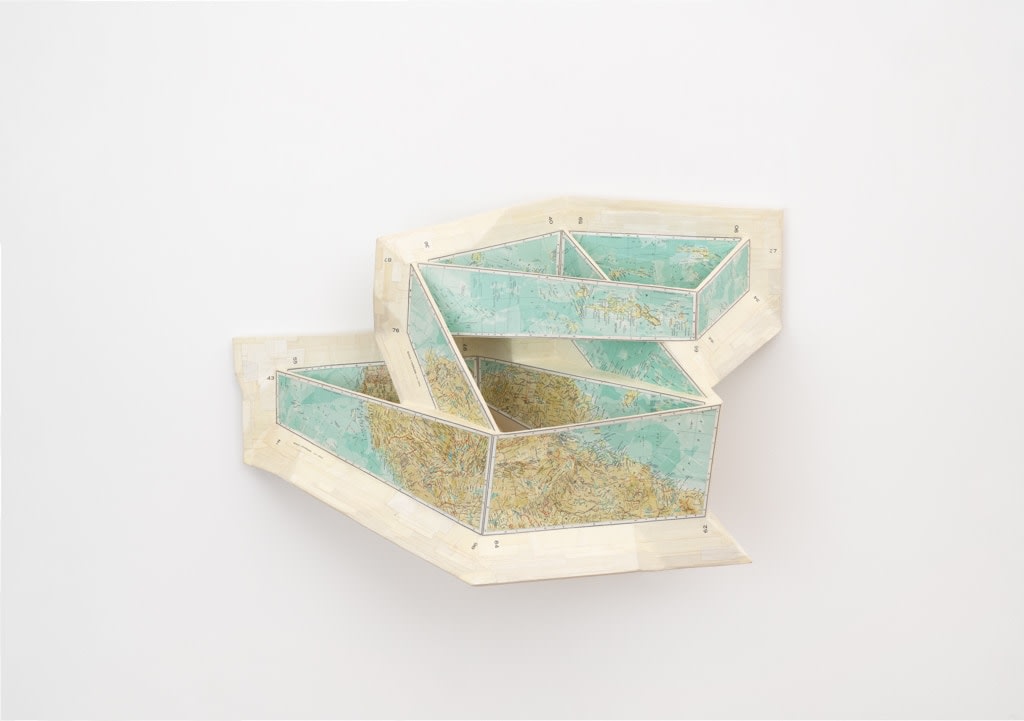
Gerhard Marx
One and three spaces, 2022
Reconfigured Map fragments on Birch ply and
water-based epoxy resin substrate
50 x 73 x 27 cm / 19.7 x 28.7 x 10.6 in.
GERHARD MARX
One and three spaces forms part of a series of sculptural and propositional cartographies that engages physical depictions of space - ‘spatial imaginaries’ – with an interest in how these descriptions affect and shape that which it describes.
The conventional ‘globe’ offers a simplified world view in which the world is presented as a singular, cohesive, and contained entity, one in which all parts are contained by the whole. In contrast with this simpification, the sculptural cartographies of this series uses the logic of collage with the aim of comprehending more complicated spacial experiences of overlap, intersection, simultaneity, relationality and overlay.
The act of laminating paper cartographies onto three dimensional form mimics the construction method of conventional globes. Curiously this act reverses one of the central concerns of cartography - the logic of projection - which transposes the continuously curved surface of the obloid earth-body onto a flat, two dimensional plane in order to make complex, dimensional information flat, manageable, portable, and inscribable. The act of transposing flat cartographies into dimensional space inverses that process: it is a moment of bringing the theoretical into the real; into dimensionality. It marks the opposite of ‘projection’ – arguably an act of ‘reflection’. The result is an object that is both drawing and sculpture, both object and conjecture.
The cartographies used to coat the work are collated from standard, educational world atlasses. The fragmentation and reconstruction of these cartographic shards pays no heed to histories, boundaries, geographies nationalities and points of origin. The logic of collage allows these dissonant fragments to be combined into a new subjective logic, suggesting a spatial imaginary which aspires to hold multiple positionalities, doubled presences, failed containments, lapsed distances, histories folded into one another, interwoven geographies, worlds that exist across, in between and amongst.
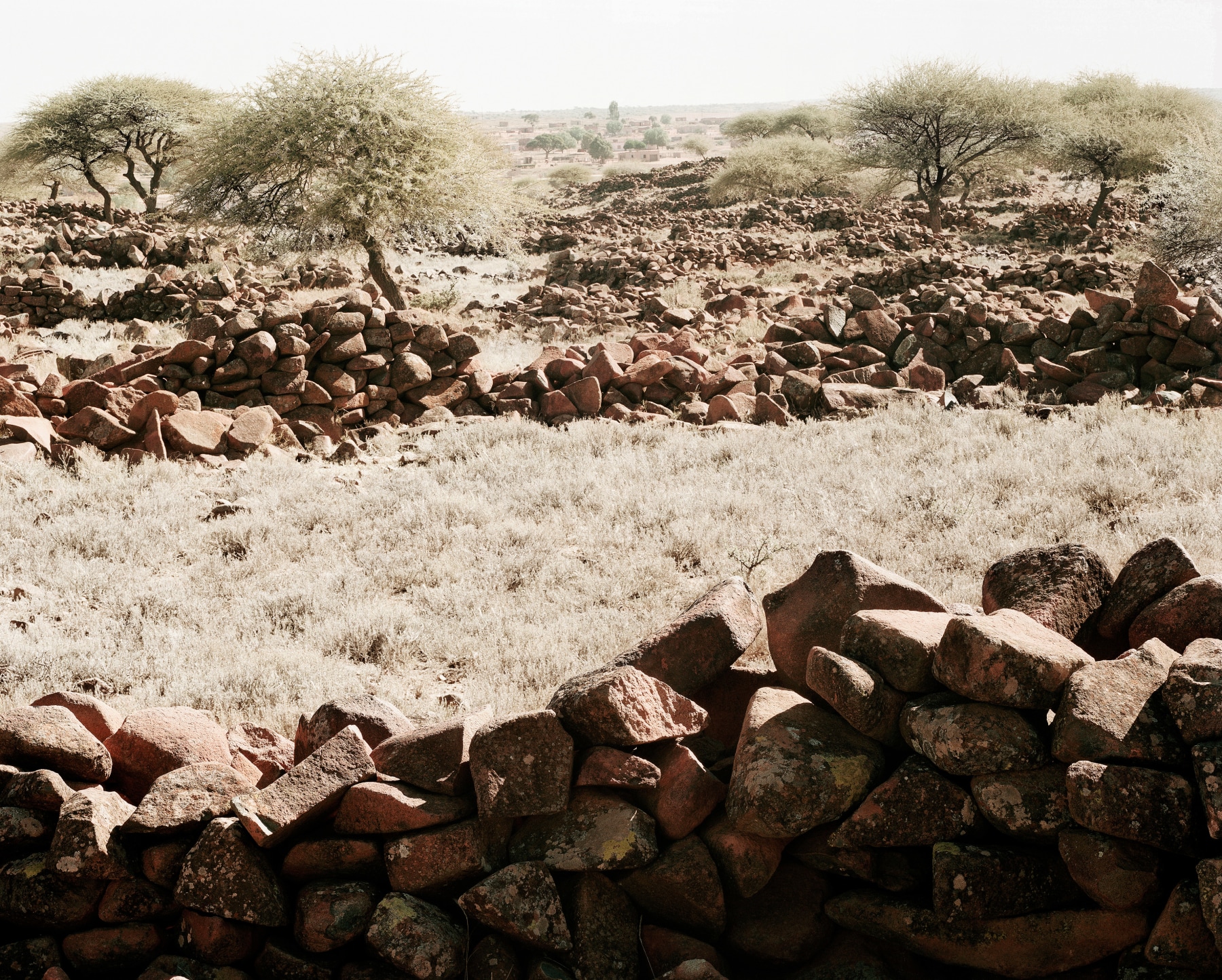
David Goldblatt
The ruins of what is thought to be a 15th or 16th century precolonial village, Dithakong, North-West Province. 13 June 2003
Digital print in pigment inks on cotton rag paper
A0+
Edition of 6
DAVID GOLDBLATT
Driving across South Africa in a kitted-out campervan, Goldblatt describes the landscape as “deep, bland, vast and seemingly featureless.” He wrote that “precisely in these qualities is a presence that is difficult to hold or suggest in photographs. As soon as you try to bring what is before you into some sort of visual coherence, it eludes, it seems to move away. There seems no focal point, no way of coherently containing it. Often it is what I call a ‘fuck all’ landscape. Somehow one has to find ways of being true to what is there and yet bringing it fully to the page or print.” (Regarding Intersections, 2014).
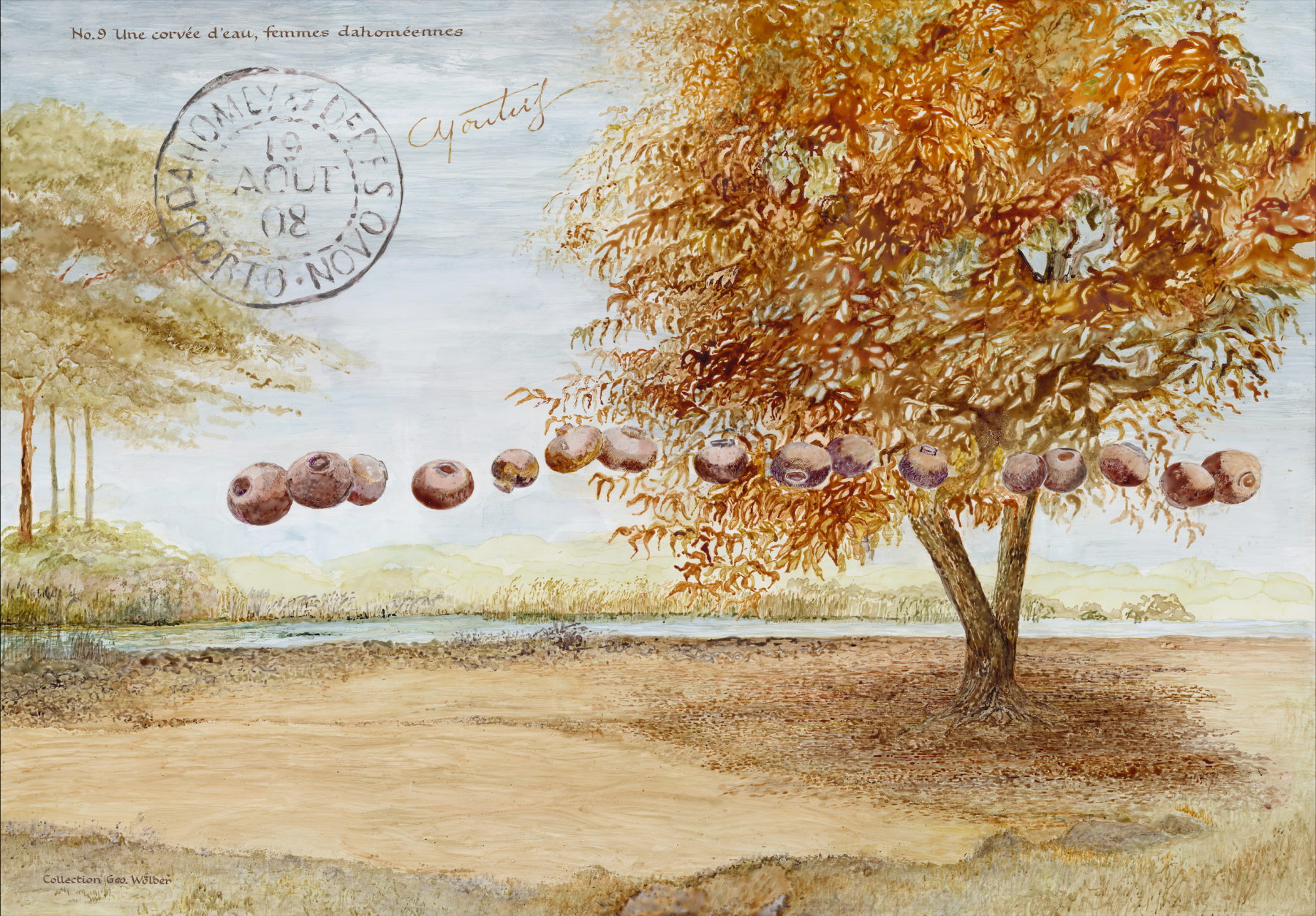
Sue Williamson
A task of water, Dahomian women, 2022
Sennelier and gouache inks on Yupo synthetic archival paper
Work: 70 x 100 cm / 27.5 x 39.4 in.
Frame: 87 x 115 cm / 34.2 x 45 in.
SUE WILLIAMSON
Williamson’s new series of drawings, Postcards from Africa, continues the artist’s interest in the power of a small printed image to carry news of a specific moment in time to a far off audience, sometimes current, sometimes separated from the event by a century. Her early series of etchings The Modderdam Postcards (1978) was based on sketches made over seven days while witnessing the destruction by the apartheid state of an informal settlement near the airport in Cape Town.
Postcards made from A Few South Africans (1983-86), mixed media portraits of heroic women active in the struggle for liberation, were distributed not only across the country but the world. Most recently, the artist has turned her attention to vintage postcards of photographs taken by European colonisers in Africa in the first decades of the 20th century, who used the postcards as examples of the success of their missions, supposedly demonstrating the civilising effect of colonisation on the colonised, or presenting views of exotic Africa. Sourcing these postcards from museum archives or from the internet, Williamson reverts to classic drawing techniques. She dips her pen into a bottle of ink, building up images with layers of intricate cross-hatching, adding colour from a limited palette to reproduce the rural landscapes on the postcards, or capture the scenes of daily community life: harvesting, swimming, gathering wood.
CARLOS GARAICOA
Through a multidisciplinary approach, Garaicoa addresses issues of culture and politics with a reflexive lens into architecture, urbanism and history.
Esquirlas/Splinters is a series of photographs sourced from Carlos Garaicoa’s archive, taken during his trip to Angola in 1996. The work proposes an archaeology of the Cuito-Menongue road, which served as a road for transporting military supplies and contributed to keeping an active first line of battle, during the Angolan war. The route along the Cuito-Menongue road consists of fragmentation of abandoned war material exposing the structures and genealogies associated with war together with geopolitics that cause them. Printed on metal, the irregular shapes that seem to fly in the air explore the idea of fragments that comes to us in the form of memory, narrating a story that seems lost in time. A story that always comes back to us in the form of new conflicts and new wars of the present.
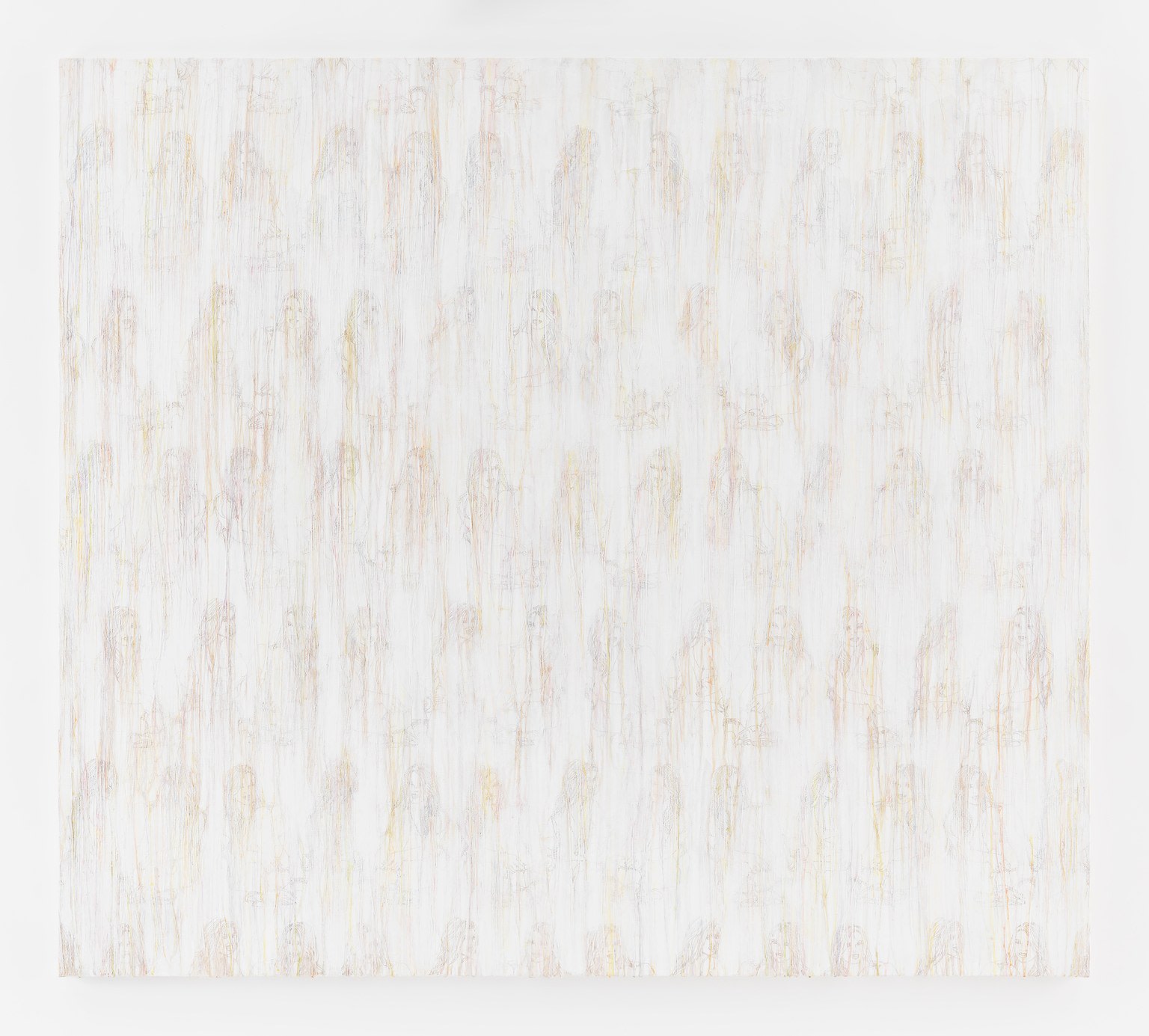
Ghada Amer
White – RFGA, 2018
Acrylic, embroidery and gel medium on canvas
162.6 x 182.9 cm / 64 x 72 in.
GHADA AMER
Many of Ghada Amer’s paintings make art historical references in subversive and humorous ways. White – RFGA is a large, monochrome thread on canvas. The transgressive erotic embroideries, which brought Amer to prominence in the 1990s, depict explicit female forms with the delicacy of needle and thread. The choice of this subject matter, rendered using thread and acrylic paint, speak to Amer’s interest in subverting assumptions related to the roles and attributes assigned to women, rejecting both religious-driven laws that govern women’s bodies as well as second-wave feminist ideas that reject expressions of conventional femininity as an avenue to empowerment.
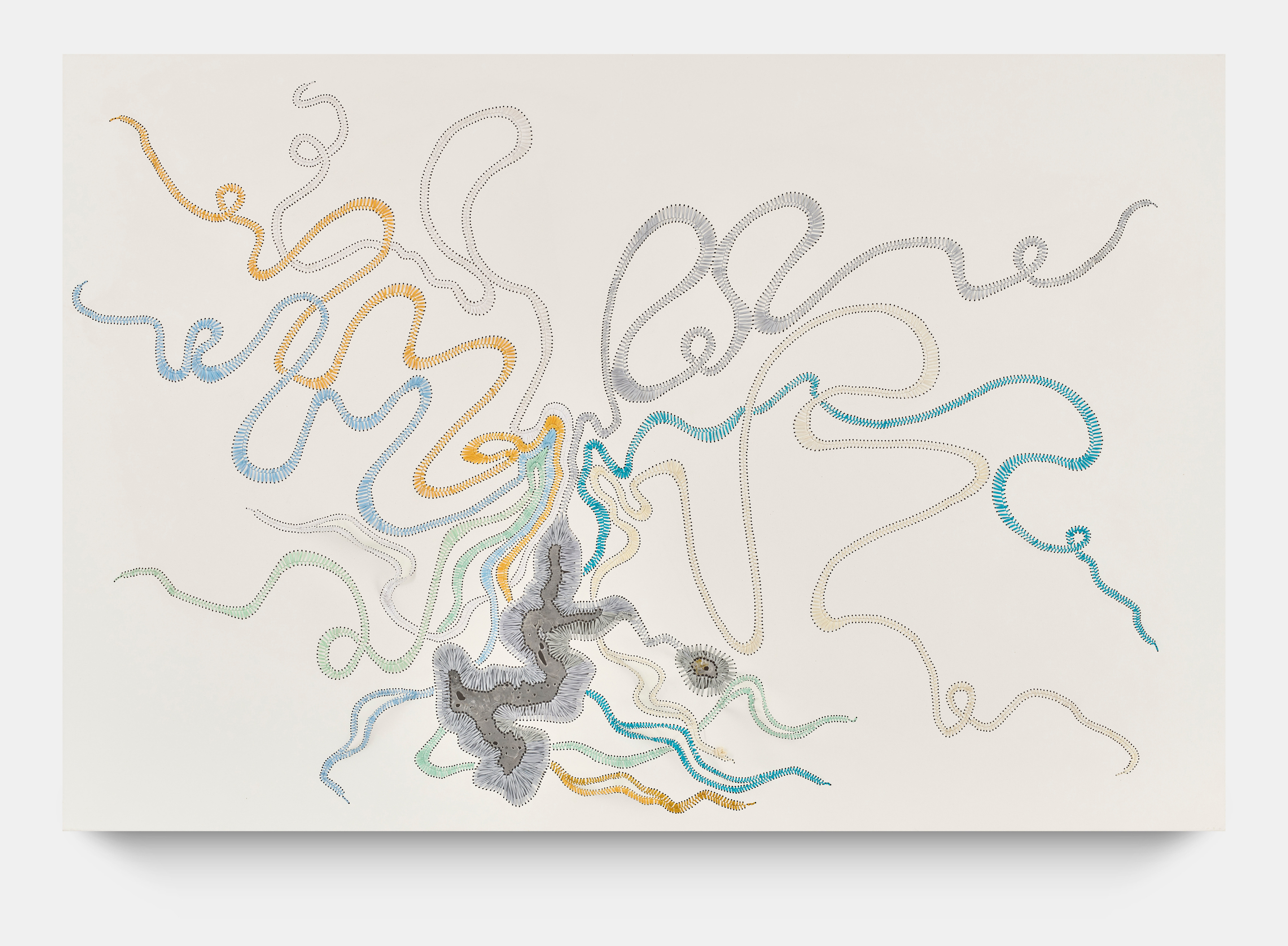
Nicholas Hlobo
Akanamva namphambili, 2021
Ribbons and lead on Belgian Linen
120 x 180 cm / 47.2 x 70.9 in.
NICHOLAS HLOBO
Working with various found objects and materials — leather, rubber, bronze, ribbons, copper and brass —Nicholas Hlobo considers his artistic practice to be a kind of autobiography through which he articulates a sense of self. Through an obscured grammar within a language of abstraction, Hlobo explores his psychological, emotional and spiritual journey. “My work is about my journey, how I relate to myself and to the outside world. I’m very curious about the invisible, intangible and incomprehensible aspects of that journey and there is always a slipperiness to the process of figuring it out”, says Hlobo.
Hlobo uses materials that have resonance to his personal memories, he explains; “Materials are found and used as a way to add more layers to the narrative. And how they are intervened with forms part of becoming a language that tells the story. Found objects have their own stories with various patinas depending on where they come from.” In “Unomalanga”, loosely translated as the sun goddess, Hlobo uses ribbons and leather on cotton canvas. As a coproduct from cattle, leather has personal significance to the artist. Within the isiXhosa culture, cattle are considered sacred and the Kraal, where they are kept, is revered as a spiritual site. The work references the sanctity of the animal and reflects on the sun through its feminine qualities.

Cassi Namoda
Shetani’s embrace amongst the cassava fields at sunset, 2022
Oil on cotton poly
122 x 152.5 cm / 48 x 60 in
CASSI NAMODA
Shetani’s embrace amongst the cassava fields at sunset engages Namoda’s exploration of Swahili folklore. In East African mythology, Shetani refers to spirits and/or demons. Namoda paints a figure of a belly dancer in a moment of uncomfortable embrace with an unwanted spirit figure. The scene is set against the backdrop of a sunset alongside a rural cassava field. The narrative is set within the context of magical realism.
With broad brushstrokes of colour painted in a bold palette, Namoda draws the viewer into the interior lives of her characters, expressing their joys, fear, love and pain.
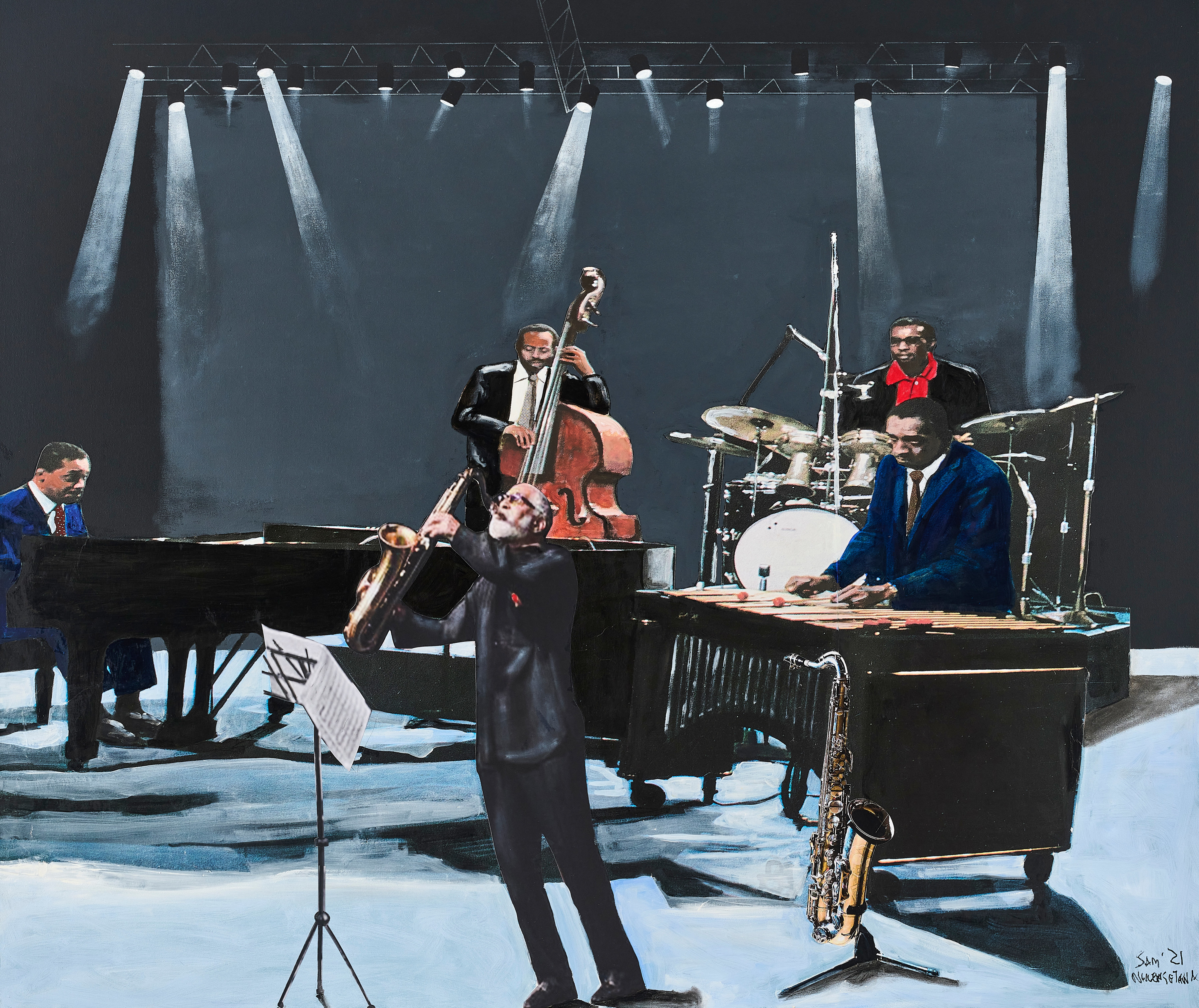
Sam Nhlengethwa
Modern jazz quartet with guest Sonny Rollins, 2021
Mixed media on canvas
109.8 x 130.1 x 9.8 cm / 43.2 x 51.2 x 3.9 in.
SAM NHLENGETHWA
Nhlengethwa was born into a family of jazz lovers; his two brothers both collected jazz music and his eldest brother was a jazz musician. ‘Painting jazz pieces is an avenue or outlet for expressing my love for the music’, he once said in an interview. ‘As I paint, I listen to jazz and visualize the performance. Jazz performers improvise within the conventions of their chosen styles’ (Nhlengethwa, S., Art Throb, 2003). In an ensemble, for example, there are vocal styles that include vocal range, call-and-response patterns and rhythmic complexities played by different members. Painting jazz allows the artist to put colour onto the music. He believes jazz emphasizes interpretation rather than composition. There are deliberate tonal distortions that contribute to its uniqueness, this enables Nhlengethwa, as a collagist and painter, to use these distortions and exaggerated patterns as a technique in exploring his artistic freedom.

Samson Kambalu
The Antelope, 2021
Bronze and resin
100 x 49 x 24.5 cm / 39.4 x 19.3 x 9.6 in.
STD 1/3
Edition of 3
SAMSON KAMBALU
Samson Kambalu works in a variety of media, including site-specific installation, video, performance and literature. His work is autobiographical and approaches art as an arena for critical thought. Kambalu’s work fuses aspects of the Nyau gift-giving culture of the Chewa, the anti-reification theories of the Situationist movement and the Protestant tradition of inquiry, criticism and dissent.
In Antelope, Kambalu restages a photograph of Malawian Baptist Preacher and Pan-Africanist, John Chilembwe and European missionary, John Chorley. Photographed in 1914, the image shows the two men who had met in 1899 and had become close friends. In the photograph, Chilembwe keeps his hat on as an act of defiance against the colonial rule which forbade Africans from wearing hats in front of white people. Through this work, Kambulu seeks to realign history by bringing to the fore untold and underrepresented narratives of resistance against
colonial rule.
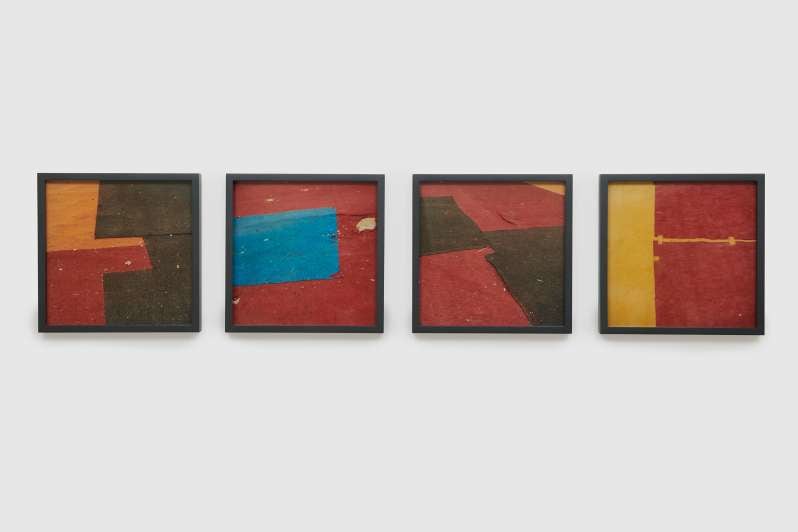
Yto Barrada
Untitled (felt circus flooring, Tangier), 2013-2015
Four chromogenic prints
Work: 30 x 30 cm / 11.8 x 11.8 in. each
Frame: 31.8 x 31.8 cm / 12.5 x 12.5 in. each
Edition of 5
YTO BARRADA
Salient to Barrada’s practice are concepts of pleasure, discovery and analysis, which are formulated through key works that experiment with materials (rust, cotton, natural dyes) and traditional processes. Her methodology is influenced by her background in history and political science. By using visual, textual and sculptural relics, the exhibition finds points of anchorage in historical narrative and aesthetic imagination and simultaneously condenses and stretches the frame of time.
GRADA KILOMBA
Kilomba’s distinctive practice draws on the repressed history of colonialism and its traumatic legacy to create new forms of knowledge. In her new series of photographic works Heroines, Birds and Monsters, Kilomba carefully captures the complexities of the characters in her video trilogy, A World of Illusions (2019); a series of filmic installations in which the artist brings the African oral tradition of storytelling into a contemporary context to illuminate memories and realities of the postcolonial world. Through this work, Kilomba poses the questions; “What if history has not been told properly? What if only some of its characters have been revealed as part of the narrative? And what if our history is haunted by cyclical violence precisely because it has not been buried properly?”
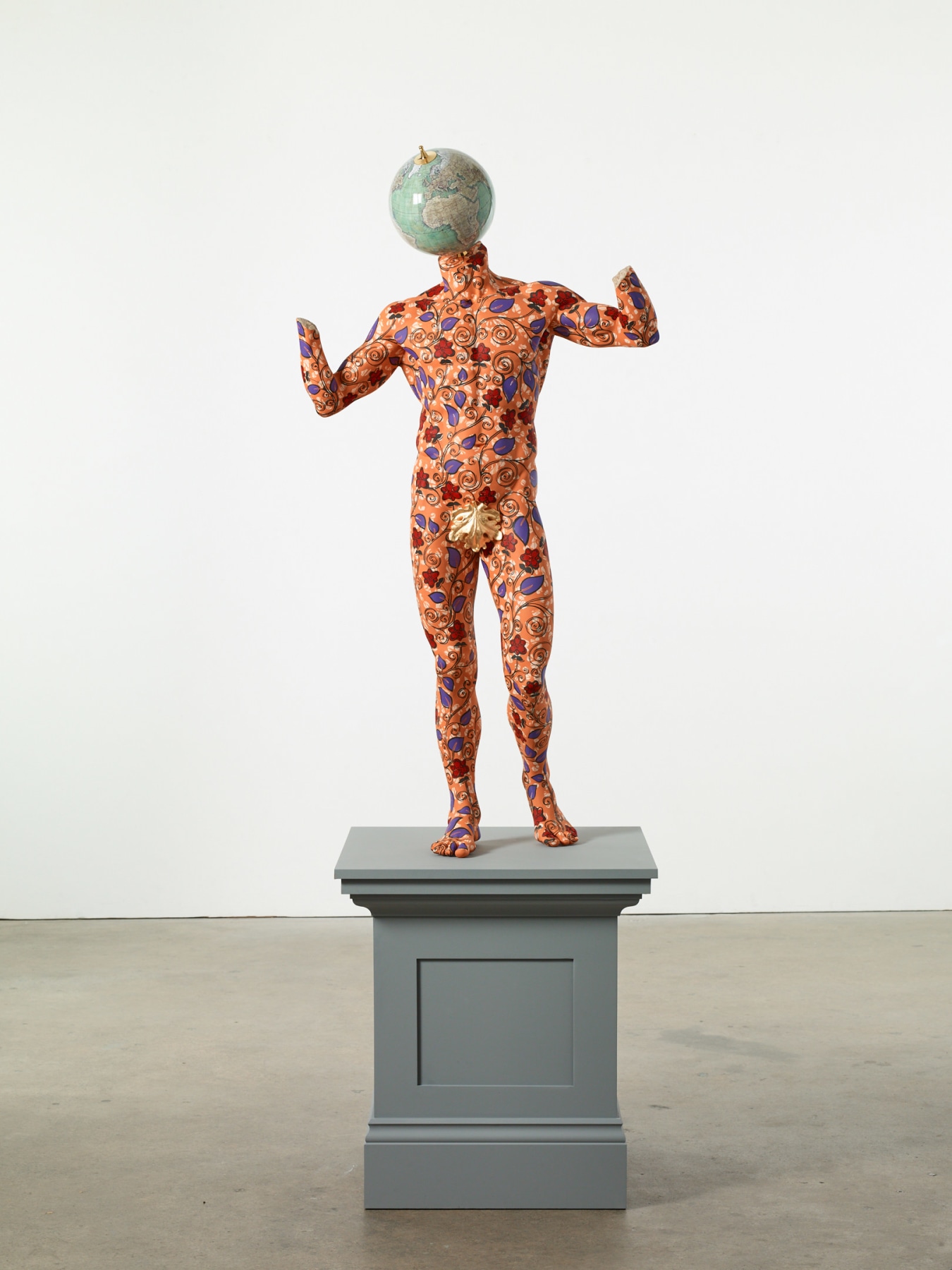
Yinka Shonibare CBE
Diadumenos, 2019
Fibreglass sculpture, hand-painted with Dutch wax pattern, bespoke hand-coloured globe,
gold leaf and steel base plate
134 x 67.5 x 33.5 cm / 52.8 x 26.6 x 13.2 in.
YINKA SHONIBARE CBE
Over the past decade, Shonibare has become well known for his exploration of colonialism and post-colonialism within the context of globalization. Working in painting, sculpture, photography, film and installation, Shonibare’s work examines race, class and the construction of cultural identity through a sharp political commentary of the tangled interrelationship between Africa and Europe and their respective economic and political histories. Shonibare uses wry citations of Western art history and literature to question the validity of contemporary cultural and national identities. In this body of works, Shonibare references iconic classical figures whose clothes have been hand-painted in the style of batik designs. Importantly these batik designs have been altered by the artists into new forms. Within these works, Shonibare places the pattern directly onto the skin. This deftly denies any notion of race and concentrates our attention on the movement of the pattern-adorned body and its connotations of sexuality, masculinity, athleticism and the ideal body.
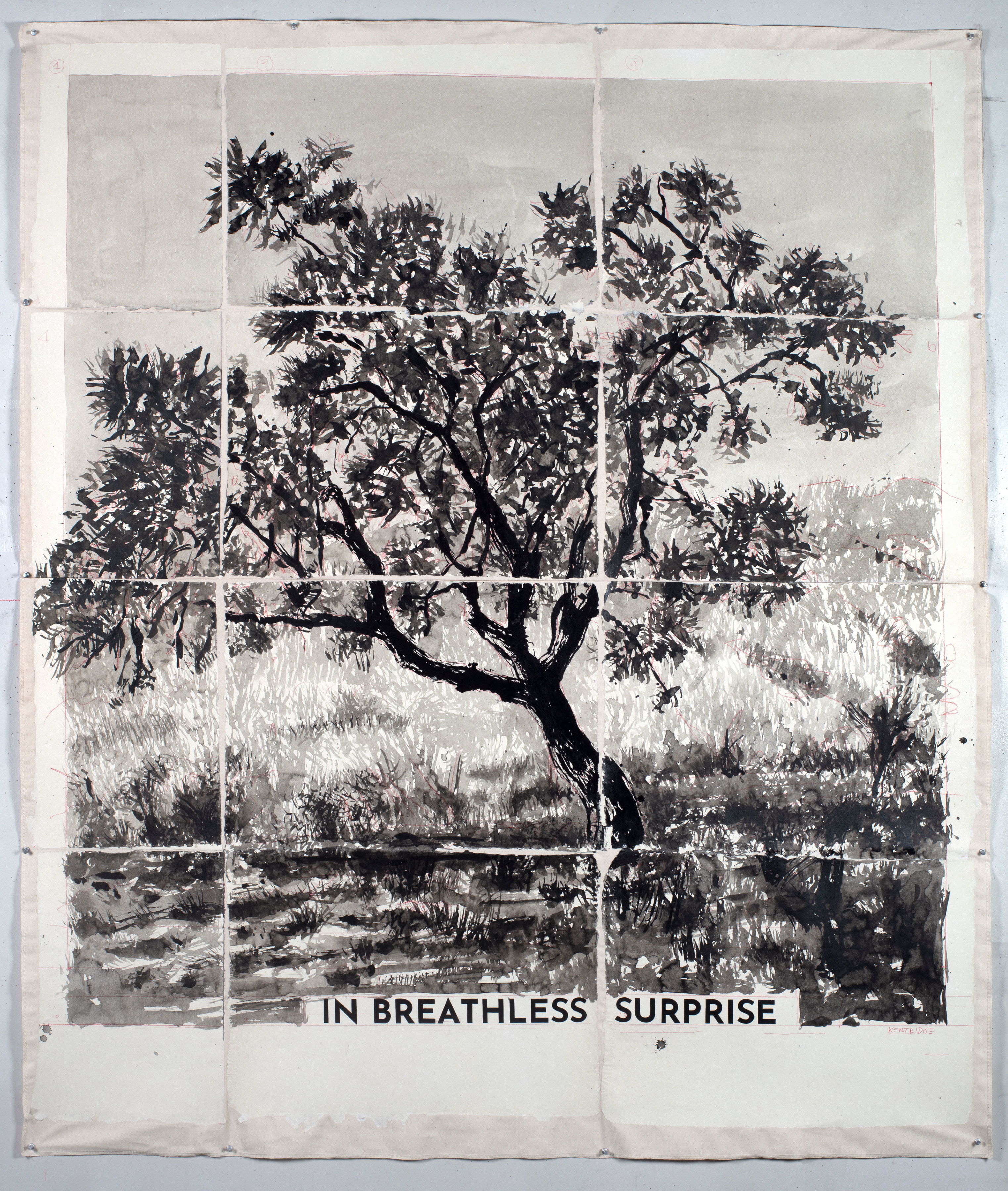
William Kentridge
In Breathless Surprise , 2022
Indian ink on Phumani handmade paper, mounted on raw canvas
174 x 151 cm / 68.5 x 59.4 in.
WILLIAM KENTRIDGE
William Kentridge’s botanical drawings of trees are rendered in Indian ink on the pages of old encyclopedias and attempt to capture the forms of trees indigenous to the area around Johannesburg. Using photographic references and drawing loosely in ink, the trees are grown page by page – each page holding only a fragment of the whole. The complete botanical forms emerge more by recognition than by a pre-existing clarity as to what the plant must look like, as the pages are shifted, layered, torn, pieces added, marks added – until the tree reveals itself as complete.
In an interview with Artnet, published in October 2021 Kentridge reflects on the images of trees as follows; “It is about allowing things to take their shape—I’m not quite sure why all these trees are being drawn. In one sense, they’re long-term self-portraits. I read somewhere a description of death that said we all grow our tree of death inside us. It starts growing when we’re born, and we have to hope that we’ll live long enough for this tree to be a great, beautiful, strong tree before it comes through us.”
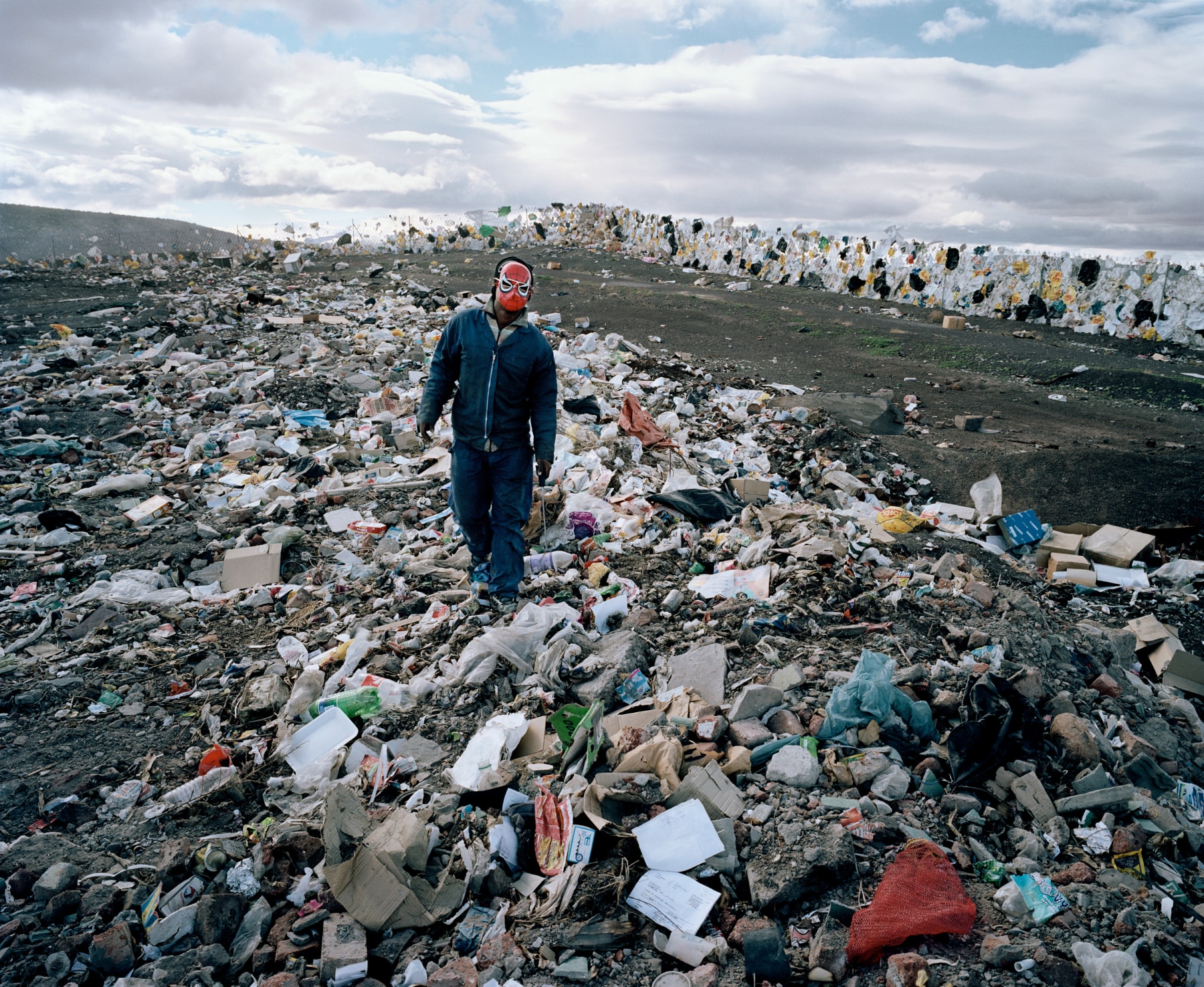
Mikhael Subotzky & Patrick Waterhouse
Samuel (walking), Vaalkoppies (Beaufort West Rubbish Dump), 2006
LightJet C-print on Fuji Crystal Archive paper
Edition of 9
126 x 147.6 cm / 49.6 x 58.1 in.
MIKHAEL SUBOTZKY
Subotzky’s photographs give you the sense that you are looking at something you have always known and yet have never seen. It is not just that the Karoo landscape in his pictures is inhabited. It is that the landscape is so patently a backdrop to the imaginings of the people in the photographs. They are using it: to transport themselves, to elevate themselves, to re-describe themselves. In picturing them Subotzky does more than simply stitch the desert and the people back together. He takes us on a sometimes disquieting adventure, asking us to imagine how the desert is imagined by those who live there.
Almost every photograph carries a suggestion of theatre, and almost every theatre uses the desert as its stage. The boy on the rubbish heap who has donned the Spider-Man mask he found in the trash; the children launching the white sheet into the wind; the screaming man and the princess on their manicured horses; the white girl with the competition tag and high heels on the black-floored stage, posing for an audience off-camera; the snake and the elephant staring so very sweetly at the ill man on the bed; the prisoner lying beneath a massive mural of cacti and sand and stone, like a giant bubble representing the inside of his mind.
Text by Jonny Steinberg
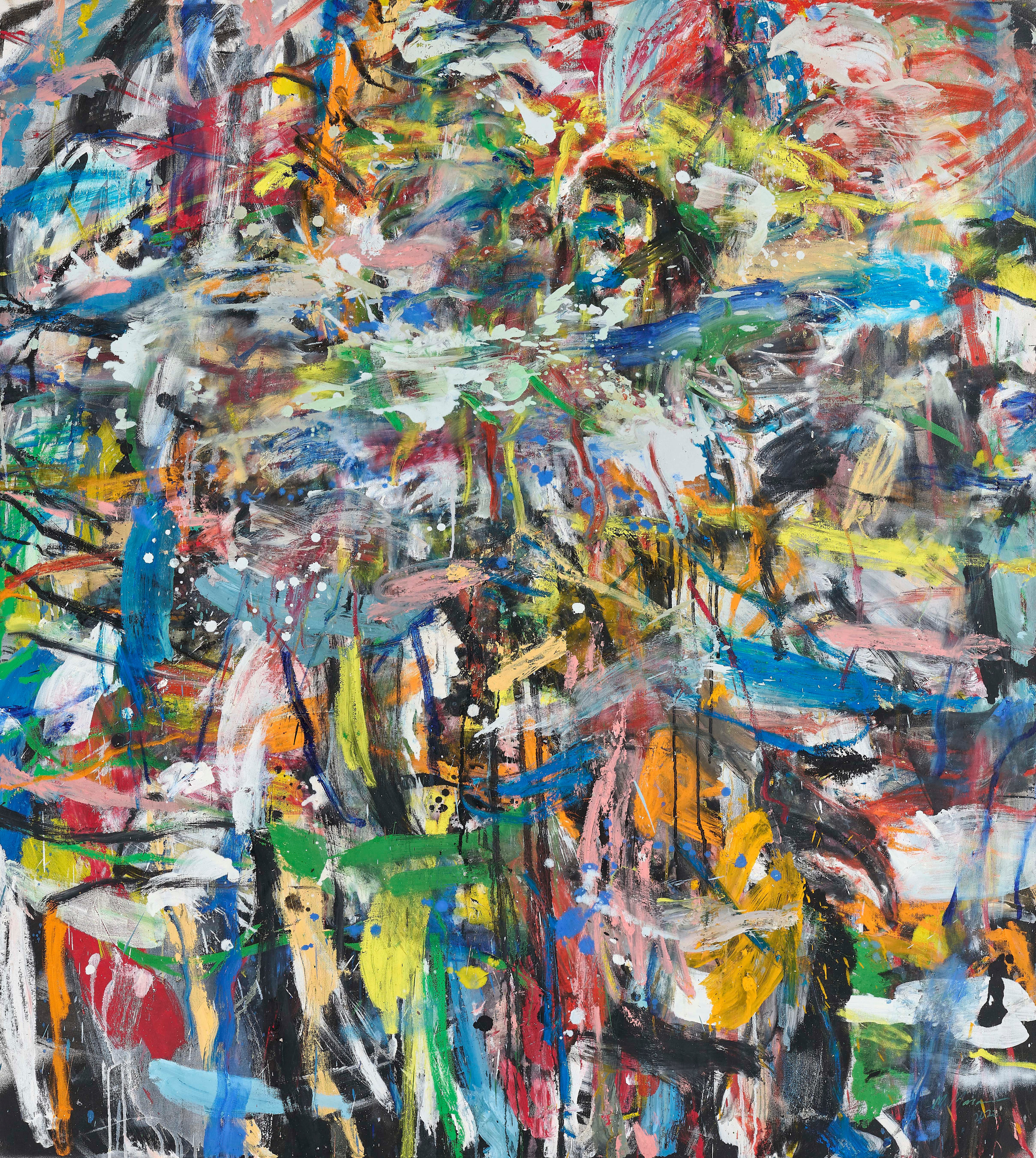
MISHECK MASAMVU
Oscillating between abstraction and figuration, Misheck Masamvu’s works allow him to address the past while searching for a way of being in the world. His layered painted surfaces and brushstrokes, which are almost visceral, give a sense of multiple temporalities existing within a singular picture plane. Beneath the surface of one painted image, lies an infinite number of images. Masamvu’s abstracted figures transform and transmute depending on the vantage point, embodying both political and social turmoil captured through the history of his homeland, Zimbabwe.
“I use figuration and abstraction in my work because I am looking for an alternative space – one that is against the forced ideology of government and the breakdown of the pursuit of humanity. For this, the symbolism of the landscape and the figure in constant states of entangled
metamorphosis are important. I am aware of the communion of the body, the soil and spirit and am interested in how transfiguration and memoirs of body and soul can evoke a real sense of vulnerability”
— Misheck Masamvu, 2021

Clive van den Berg
Phlegethon I, 2021
Oil on canvas
240 x 240 cm / 94.5 x 94.5 in.
CLIVE VAN DEN BERG
On the nature of this theme in his work, Van den Berg notes: “A swelling of earth, a hollow or dispersed pile of stones that once marked a grave or embattlement, are the grammar of my landscape vocabulary. These vestigial mutterings of geography are the prompts that I respond to in making my work, a kind of interstitial speech, connecting the remnant to its repressed or forgotten source… I grew up in Luanshya, a small mining town in Zambia and now live in Johannesburg, one of the largest of all mining towns. Perhaps it is the occasional shaking of the land, its stuttering as a shaft collapses or a plate realigns, or indeed the sudden appearance of sinkholes, those most compelling of negative spaces that first made me curious about that other landscape, the underscape.”
For Van den Berg, land serves as a powerful marker for the anxieties contained in both the personal and the political. The artist seeks to unpack this by separating the idea of land into the spheres of ‘above’ and ‘below’ ground. Using this dichotomy the artist is able to differentiate between what we idealise on the surface, and what exists unresolved below. Historical depictions of land, which were primarily filtered through Western perception, sought to possess the territory by recording its surface image. In turn, Van den Berg confronts the tradition of South African landscape painting, by peeling “the surface off the land and mak[ing] the landscapes porous”.























